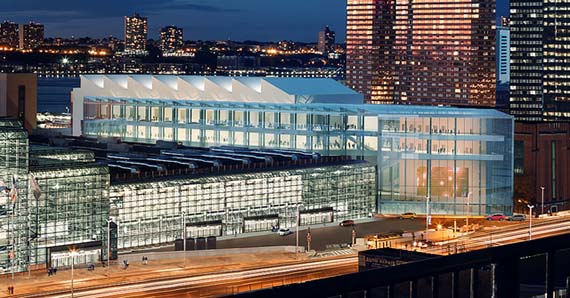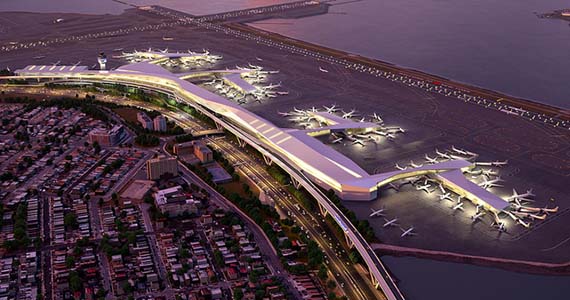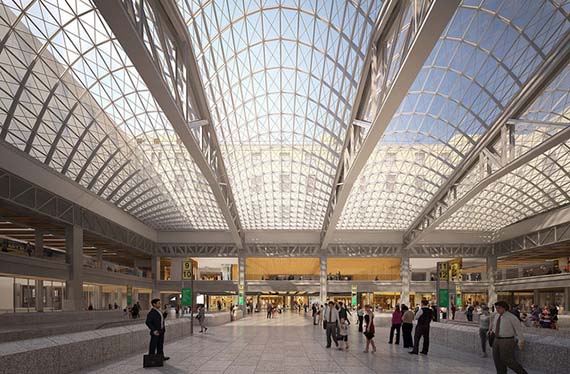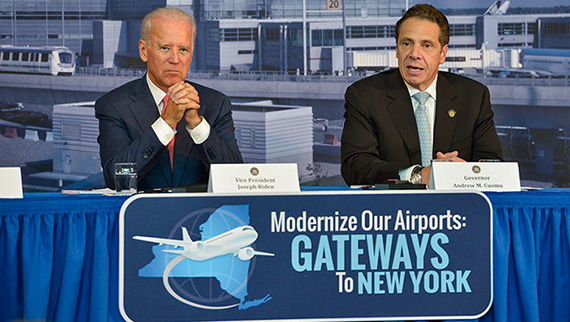TRD Special Report: A year into his second term, Gov. Andrew Cuomo is a man with a limited legacy. Well before fiascoes like the Moreland Commission, there were triumphs: He signed same-sex marriage into law just months after taking office, and in 2013, inked what he calls the “toughest” gun control law in the country.
But when it comes to being a gubernatorial icon, nothing says “remember me” like giant infrastructure projects. On their paths to the White House, Franklin Roosevelt and Nelson Rockefeller constantly touted their records of public works that transformed New York. Cuomo, who likely shares their presidential ambitions, has some catching up to do.
Which is perhaps why, in the days leading up to his sixth State of the State address, the governor evoked the names of Rockefeller and Robert Moses. The parallels were in reference to his Built to Lead program, a proposed $100 billion investment in the state’s infrastructure that includes overhauls of LaGuardia Airport, Penn Station and the Jacob K. Javits Center.
“It is a development initiative that would make Gov. Rockefeller jealous,” Cuomo said of the program.
These are not exactly modest comparisons. Rockefeller created the predecessor to the Empire State Development Corporation, and Moses, though controversial, is a colossus of urban infrastructure. But they make clear that Cuomo is willing to bet that big development projects will serve as his springboard to higher office. If they are actually completed, that is.

Rendering of the Jacob Javits Center
“These [developments] would be the most visible and the most tangible memorials to his term in office,” said David Birdsell, dean of the Baruch College of Public Affairs. “But the projects need to be received well. Clearly, you don’t want to become the rest stop on the New Jersey Turnpike.”
The ‘get shit done’ guv
In his 2011 inaugural address, Cuomo laid out the parameters of his office.
“A governor’s inherent power is limited. A governor’s potential power is limitless,” he said. “The potential power of the governor is to mobilize the people of the State of New York. And that is the real power.”
The highlight of his tenure, so far, is the New NY Bridge, a $4 billion replacement of the Tappan Zee Bridge. His administration said that after “more than a decade of discussion and delay,” Cuomo swooped into office and “pushed the project forward from dysfunction to construction in less than one year.” The eight-lane bridge is slated for completion in 2018 and, in many ways, is a case study for Cuomo’s governing style.
“This is a governor who says he wants to get stuff done. His shtick is ‘I get shit done,’” said Philip Plotch, an urban planner who served as the director of the World Trade Center redevelopment and special projects for the Lower Manhattan Development Corporation.
Cuomo’s approach to the project did indeed have echoes of Moses, according to Plotch, but perhaps not for the reasons the governor would have hoped: He was able to get the project off the ground, Plotch said, by eliminating previously-included mass transit components, scaling back the project and minimizing public participation. Speed trumped all else. The governor, Plotch said, was more interested in “public relations” than “public input,” and made major project decisions behind closed doors. Representatives for the governor contested this, pointing to roughly 600 community meetings held on the project. Plotch said that public meetings held during Cuomo’s administration were held to sell the plan rather than solicit input.
He also noted that Cuomo secured a $1.5 billion Transportation Infrastructure Finance and Innovation Act (TIFIA) federal loan for the project, allowing him to have the glory of bridge-building while leaving the headache of repayment to his successor.

Tappan Zee Bridge
“So you get to go to the ribbon-cutting, you can name the bridge after your dad if you want, and you don’t have to pay back the loan for five years,” Plotch said.
Still, some applaud Cuomo’s approach. Ken Patton, a former dean at New York University’s Schack Institute of Real Estate and former administrator at the New York Economic Development Corporation, said continuing to ignore the bridge’s sorry state would have been “shortsighted and morally bankrupt.”
“I think where there’s a will there’s a way, and I think if he needs to bend the rules or double down, he does,” Patton added.
In 2014, Cuomo took heat for trying to use $511 million from a revolving Environmental Protection Agency fund for the bridge project. The agency eventually agreed to contribute just $1.3 million. As of right now, bridge costs, thanks in part to a proposed $1.1 billion bond from the state Thruway Authority, are covered through the remainder of 2016 and possibly through the first quarter of 2017, according to administration officials. Martin Robins, the founder of the Alan M. Voorhees Transportation Center and one of the creators of NJ Transit, said that though funding questions remain, Cuomo has secured “sound” low-interest public financing and got agencies to work together when his predecessors could not.
“Some people think it was brilliant and some people think it was reckless,” Robins said of Cuomo’s approach. “He broke an intergovernmental knot that had developed, it was a Gordian knot between the Metro-North, DOT and Thruway Authority.’’
Like the New NY Bridge, many of the projects Cuomo is focusing on have been several decades in the making and have failed to launch for myriad reasons. Efforts to redesign Penn Station began in the 1990s but were stalled by faulty design specifications. Laments over LaGuardia Airport’s logistical shortcomings fell on deaf ears. And, for several years, many called for an expansion of the Javits Center but Cuomo, in 2012, suggested a plan to tear it down and build a new one — a plan that eventually fell through.

Rendering of LaGuardia Airport
But in the past year, Cuomo has restarted the redevelopment of Penn Station, unveiled a $4 billion redesign for LaGuardia and proposed a 1.2 million-square-foot expansion to the Javits Center, expected to cost $1 billion. These projects may not have gotten their start with Cuomo, but in one way or another, he has taken them over. Critics say he is simply parlaying his white-knight role in these long-stalled developments into a presidential run. But admirers point to sheer force of position: As governor, Cuomo has the necessary agency to prioritize these projects, and to cajole or bully the involved parties to get them done.
“It’s the old ‘If you don’t have governor power, things don’t happen,’” said Richard Anderson, president of the New York Building Congress. “What Gov. Cuomo has realized is that he’s the only person in the state of New York that can make some of these things happen.”
Tunnel vision
In the late 1990s, the late U.S. Sen. Daniel Moynihan proposed converting the James A. Farley Post Office into a train hall for Amtrak. In 2005, Related Cos. and Vornado Realty Trust won an RFP to develop the Moynihan Station project. Since then, the project has seen four different designs, one of which included moving Madison Square Garden into the post office. Sources who have followed the project’s history closely told The Real Deal that previous administrations let the project languish even as the developers invested millions. This lack of government interest caused MSG to pull out and instead renew at its current location, these sources said. What followed was years of an unsuccessful search for a new tenant for the post office. Then the market collapsed.
“I think the project came pretty close in 2007 and 2008 when it was Vornado and Related creating a plan for both sides of Eighth Avenue,” said Juliette Michaelson, executive vice president of the Regional Plan Association, a nonprofit urban planning think-tank whose board includes executives from both developers. “That was such a massive project. It was tens of billions of dollars and millions of square feet, and it collapsed.”
In January, Cuomo booted Related and Vornado off the project by issuing a joint request for proposals (RFP) for the $3 billion redevelopment of both Penn Station and the Farley Building, dubbed the Empire State Complex. The separation may be temporary: Related has indicated that it plans to pursue a bid for this iteration. Though Vornado has remained quiet about its future role, the company has worked hard to amass a huge stake in the area in the form of 8 million square feet of office space.
The new RFP includes five possible design options for the redevelopment of Penn Station, one of which includes removing MSG’s Paramount Theater to create an entrance at Eighth Avenue. Representatives for MSG declined to discuss the history of the project but said that they “fully support the governor’s plan.”
According to representatives with the Empire State Development Corporation, one of the lead agencies on the project, past efforts to expand Penn Station were hamstrung by the projects being approached in isolation, rather than as one interconnected complex. Cuomo is also trying to implement a different delivery system to speed up the project. In his 2016 budget proposal, he suggested allowing ESD to use design-build, a method where the landlord signs a single contract with a team that handles both design and construction. Only five state agencies currently have the authority to use the method, which is often touted as a time and money saver. Design-build was used for the new Tappan Zee Bridge and by some estimates has shaved 18 months off the construction time and roughly 15 percent off the cost.
Michael Evans, president of the ESD subsidiary Moynihan Station Development Corporation, and Joseph Chan, executive vice president of real estate development at ESD, credited the governor’s focus on getting buy-in from Amtrak and other entities.
“As staff we can toil away at any project,” Chan said, “but when the principal gets involved and says this is important, it delivers a level of hope to the stakeholders that this is going to get done.” Representatives for Vornado and Related declined to comment.
Executives at Skidmore, Owings and Merrill, an architecture firm which has been involved with the Moynihan Station project since the 1990s but officially came on board in 2010, said it had limited access to the post office until 2007, when the state acquired the building.

Rendering of the Farley Building redevelopment
“This [version of the project] is realizable. The other one wasn’t funded, it didn’t have the political traction to move forward,” said Roger Duffy, design partner at SOM. “Lots of people are focused on the symbology of things, and I think that misses the entire primary point of a transportation facility. This is certainly beautiful and appropriate in terms of history and scale, but it also works. People need to understand how much better this is than the current condition.”
The plan has its share of detractors, however. David Gunn, who was president of Amtrak from 2002 to 2005, wasn’t initially aware of the governor’s plans to reboot the project when reached by phone. But he reiterated his previous criticism of the redevelopment, saying that moving Amtrak’s train hall across Eighth Avenue would burden passengers with a longer commute. (Gunn said that most passengers arrive by subway; ESD officials contend that most come by cab). Commuters aren’t interested in shopping at a retail mall in Moynihan, Gunn said — they just want to get from A to B as quickly as possible.
“It is not an improvement for the passenger,” he said. “It’s an improvement for the real estate developers and the politicians. Cuomo probably doesn’t have a clue, or he doesn’t care.” Cuomo has certainly been accused of being buddy-buddy with developers before, and his strong financial ties to the real estate industry — developers and brokers were among the top contributors to his reelection campaign — ensure it’s a topic that often comes up.
Ultimately, better design or not, a $3 billion question remains: The governor hasn’t detailed how these projects will be financed. Richard Ravitch, who served as lieutenant governor under Gov. David Paterson and earlier chaired both the New York State Urban Development Corporation and the Metropolitan Transportation Authority, said that these infrastructure projects aren’t really priorities until there is a clear source of funding.
“These projects are all commendable,” Ravitch said. “I think the question that the political system hasn’t answered is ‘how the hell are we going to pay for it?’ I think until we get an answer to this question, all these projects are purely aspirational.”
Cuomo’s camp maintains the governor has laid out clear funding plans for these projects. For Empire Station Complex, Cuomo said the developers will invest $1 billion, while federal and state government agencies will foot $325 million. The rest will be paid for by yet-undetermined private investment in exchange for future revenue from retail and commercial rents at the complex.
Bill Mulrow, Cuomo’s top aide and a former senior executive at the Blackstone Group, said these projects would shape the state’s legacy, rather than just Cuomo’s. The governor isn’t in the business of proposing projects that won’t get done, he added, citing the example of the New NY Bridge.
“He’s focused on it, and we already demonstrated that we’re getting results with a project that had languished for decades,” Mulrow said. “This isn’t just ‘throw something against the wall and see what sticks.’ These are all projects that are going to get done.”
Higher ground
Some believe Cuomo’s ambitious development agenda is a ticket out of Albany. If a Democrat takes the White House in 2017, Cuomo will either run for re-election after his second term ends in 2018 or find another job and wait for his shot at the presidency, said Gerald Benjamin, an expert on city and state government at SUNY New Paltz. If a Republican wins, Cuomo may make a play for the office sooner. For now, he is systematically rolling out ambitious projects, taking financial risks and figuring out what it will take to get them done on the fly, Benjamin said. To fail to complete these projects would be somewhat damning for Cuomo, he said, but not necessarily a calamity.
“He’s trying to fill out his resume,” said Robert Shapiro, president of City Center Real Estate and an expert on air rights and assemblage. “If you got the proposal out there, you can say, ‘this is what I’m trying to do for the city and the state.’”

From left: Joe Biden and Andrew Cuomo (credit: Governor’s office)
Shapiro isn’t confident the projects will be completed, saying they have an “eternal life.”
Pulling off these “big tough brawny projects” would surely give Cuomo bragging rights for the rest of his political career, Baruch’s Birdsell said. To his credit, Cuomo can also boast reversing a “remarkable scheme of failure” that dates back to his father’s administration: Late state budgets. Under Cuomo, the state has passed a balanced budget by deadline fives times in a row (though, last year’s was technically late by a few hours), which isn’t a small feat, Birdsell said. But when it comes to visible testaments to his mettle as a leader and his ability to cut through bureaucratic morass, these projects would get the most mileage — a fact that some say has shifted his focus.
This change was good news for the beleaguered ARC tunnel, the proposed new rail tunnel under the Hudson River. Following years of silence, Cuomo only recently embraced the project, now known as the Gateway Tunnel. As recently as August, the governor said he wouldn’t pay for it, insisting it wasn’t his state’s responsibility. But in November, the federal government agreed to pay for half of the $14 billion project, with New York and New Jersey splitting the difference.
‘We have been working to break the federal logjam and get the federal funding that this massive undertaking requires,” Cuomo said at the time.
Robins, who worked as project director on the ARC tunnel from 1994 to 1995, noted a “remarkable transformation,” with Cuomo going “from being recalcitrant to becoming a partner to the plan.”
The governor apparently recalibrated his focus on LaGuardia as well. In late 2014, Cuomo and Vice President Joseph Biden announced a contest to redesign the airport. At the time, Joseph Sitt, head of Thor Equities and chair of the Global Gateway Alliance, a group that advocates for a major overhaul of the airport, criticized the governor for using the much-needed improvements as political capital — Cuomo was up for re-election.
The hope now, Sitt said, is that Cuomo views the success of the project as essential to his political future.
“We’ve tried so hard to make this a political issue for him,” Sitt said. “We’re hopeful that we’ve made it important enough in the eyes of the constituents, that yes, it will make a difference to his future and his future in politics. Our role, as we see it, is to hold the governor’s feet to the fire.”
For more than a decade, the alliance pushed for major improvements at the airport but their pleas were ignored, Sitt said. He added that though the governor may be using LaGuardia and other projects to pave his path to the White House, he is also delivering much-needed infrastructure updates to the state.
“I think he’s got higher hopes. He hopes to one day run for president,” he said. “At the same time, I think he sincerely wants to see these things get done.”
